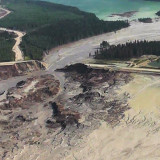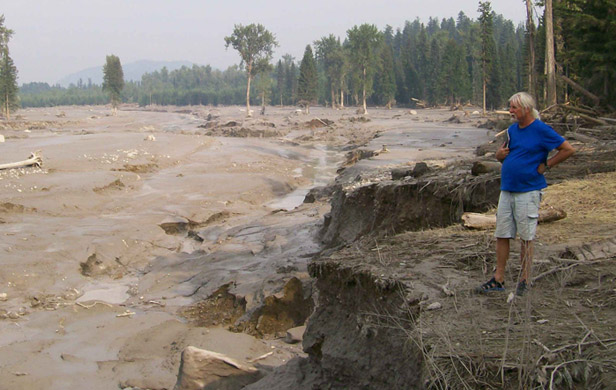
Rweprinted with permission from DeSmog Canada.
Move over Duffy diaries. There’s a new black book in town.
That’s the detailed work journal of B.C. Ministry of Environment senior official Frazer McKenzie, which recounts conversations between ministry officials and Rio Tinto Alcan while the company was applying for a permit to increase aluminum production at its Kitimat smelter.
“Frazer McKenzie was a diligent and thorough employee. He documented ongoings with Rio Tinto Alcan within government that we’d otherwise never know about,” lawyer Chris Tollefson told DeSmog Canada.
The hen guarding the fox house
During the application process, Rio Tinto Alcan financed McKenzie’s position at the Ministry of Environment through a secondment agreement and government officials repeatedly refer to the company as a “client.”
DeSmog Canada has learned this parlance has become commonplace between ministry officials and industry. Indeed, much of what occurred in the Rio Tinto Alcan case appears to be standard operating procedure.
McKenzie’s journal — made public due to an appeal — offers a rare glimpse into the inner workings of B.C.’s Ministry of Environment.
The ministry has argued that it agreed to allow the company to fund McKenzie’s position because of concerns there would be “inadequate staffing to deal with the application” otherwise. Such arrangements with industry are not entirely unusual due to chronic underfunding.
Rio Tinto Alcan’s application, which was approved by B.C. in 2013, granted the company the right to increase sulphur dioxide emissions in the Kitimat airshed by 56 per cent.
Sulphur dioxide is released from the combustion of sulphur-laden fossil fuels — such as the petroleum coke used to smelt aluminum — and irritates eyes, noses, throats and lungs. People with asthma, children and the elderly are at increased risk from sulphur dioxide exposure.
Two Kitimat elementary school teachers — Emily Toews, who suffers from asthma, and Lis Stannus — are now challenging that permit approval through the B.C. Environmental Appeals Board, arguing the project threatens human and environmental health. The appeal, being heard by a tribunal in Kitimat, is in its third week.
“This case really does represent a situation where you have a regulator that has gotten too close to a powerful and well-resourced private interest that it is supposed to be independently regulating,” Tollefson told the tribunal.
 Central to the tribunal are the extensive notes McKenzie took while the Ministry of Environment, including manager of environmental protection Ian Sharpe, and Rio Tinto Alcan discussed the company’s permit application.
Central to the tribunal are the extensive notes McKenzie took while the Ministry of Environment, including manager of environmental protection Ian Sharpe, and Rio Tinto Alcan discussed the company’s permit application.
On Monday, Sharpe told the appeals panel Rio Tinto Alcan was “after comfort in the authorization process” and that he discussed the possibility of creating “some kind of comfort letter or document…that would give Rio Tinto Alcan’s board the comfort they needed to get on with funding.”
“This is B.C.’s version of the Duffy senate scandal: it shows how deeply comfortable government and industry are with one other,” said Richard Overstall, counsel for Emily Toews.
BC left sulphur dioxide limits unanswered
McKenzie’s notes show the provincial government was aware of scrubbing technology — used to eliminate sulphur dioxide emissions from smelters around the world — but chose not to require Rio Tinto Alcan to put that technology in place.
Under cross-examination, McKenzie read aloud his notes, which referenced Rio Tinto Alcan’s request to eliminate the mention of scrubbers from an internal memo. He also noted a phone call from a deputy minister who “did not want to let a little SO2 get in the way” of Rio Tinto Alcan’s project.
McKenzie’s journals also show the company was anxious about the projected increase of sulphur dioxide emissions from the modernization project and wanted regulatory certainty to calm investors.

Rio Tinto Alcan requested specific sulphur dioxide discharge limits during the creation of a joint memorandum of understanding (MOU) with the province. Under the MOU, the province committed to regulate Rio Tinto Alcan under sulphur dioxide standards from the 1970s — and guaranteed those weak rules would stay in effect for the project until at least the end of 2018, even though the province introduced much stronger interim standards in 2014.
Those weak standards were eventually dropped altogether by Sharpe, who said he began to consider them “obsolete,” but told the panel he could not recall when. No new standards for Rio Tinto Alcan’s smelter have been put into place and, according to Sharpe, won’t be in place until B.C. or the federal government mandate them after conducting a full public consultation.
McKenzie’s notes make numerous mentions to Rio Tinto Alcan’s desire for “certainty” regarding potential SO2 standards.
“SO2 is troubling to Alcan,” McKenzie wrote in one entry entered into evidence. “Insisting they have limit ahead of time — something in writing.”
McKenzie noted in one internal correspondence:
[quote]Alcan is anxious to get green light…to provide good news on project to stakeholders.[/quote]
The province approved the company’s permit in 2013 but did not release an environmental monitoring plan until 18 months later. Although the modernization project is very close to complete, it remains without sulphur dioxide emission limits.
Appellants point to regulatory capture
Between the period of 2007 and 2013, McKenzie was seconded to Rio Tinto Alcan, which funded his position. He worked closely with the company during the permit application process.
Tollefson argues Sharpe’s close ties with Rio Tinto Alcan influenced and ultimately fettered his decision-making.
The evidence shows that government of B.C. and Rio Tinto Alcan “deliberated carefully over the language” contained in their agreement “knowing that it might be challenged in court on the ground that it fettered the discretion of the decision-maker charged with granting the permit,” he told the panel.
[quote]We need to reinvigorate the idea of a regulator as a fearless public defender[/quote]
That was not the case with Ministry of Environment officials, who, according to Tollefson, throughout years of documents refer to Rio Tinto Alcan as a “client” and tend to view the world through “industry-coloured glasses.”
Overstall said there was a “slow creep” of industry’s interests into government activities.
“That’s what we see with the Duffy scandal: these guys get so involved they lose their compass,” he said.
“No one wakes up one morning and decides, ‘I’m going to get cozy with industry.’ It’s more of a slow creep,” Overstall said. “They make small decisions one after another behind closed doors thinking what they’re doing is okay until suddenly the public spotlight is shone on them.”
























